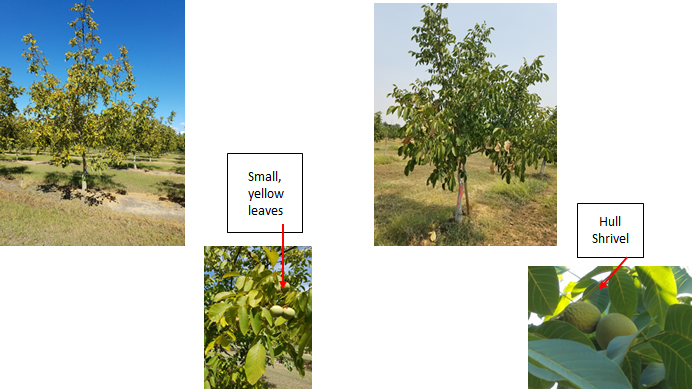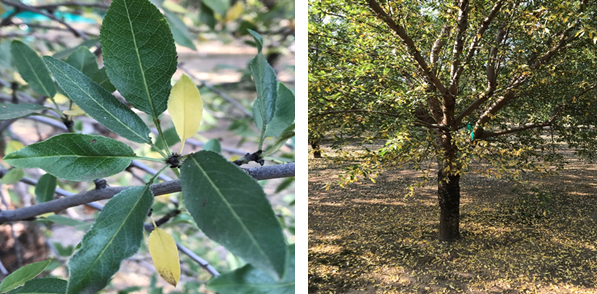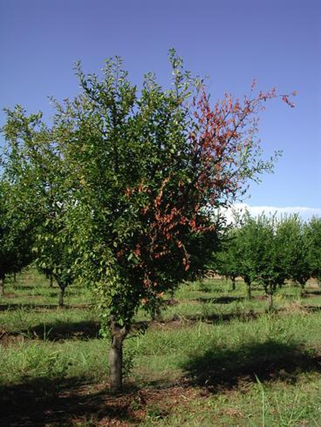Allan Fulton, UCCE Water Resources Advisor, Tehama, Shasta, Glenn and Colusa Counties; and Luke Milliron, UCCE Orchards Advisor, Butte, Tehama and Glenn Counties.
SWP Levels Vary Among Orchard Crops
What do the pressure chamber measurements mean? The range in stem water potential (SWP) stress levels vary substantially between crops. This post highlights general guidelines for interpreting SWP measurements in walnut, almond, and prune. A main goal of measuring SWP is to track tree water status and detect tree stress level before symptoms are visible and the stress become harmful to the tree or crop. For an introduction to the more advanced practice of incorporating the weather into the interpretation at the time of the reading, please see this post.
| Pressure Chamber Reading (- bars) | Walnut | Almond | Prunes |
| 0 to -2.0 | Not commonly observed | ||
| -2.0 to -4.0 | Fully irrigated, low stress, commonly observed when orchards are irrigated according to estimates of real-time evapotranspiration (ETc), long term root and tree health may be a concern, especially on California Black rootstock. | Not commonly observed | |
| -4.0 to -6.0 | Low to mild stress, high rate of shoot growth visible, suggested level from leaf-out until mid-June when nut sizing is completed. | ||
| -6.0 to -8.0 | Mild to moderate stress, shoot growth in non-bearing and bearing trees has been observed to decline. These levels do not appear to affect kernel development. | Low stress, indicator of fully irrigated conditions, ideal conditions for shoot growth. Suggest maintaining these levels from leaf-out through mid-June. | Low stress, common from March to mid-April under fully irrigated conditions. Ideal for maximum shoot growth. |
| -8.0 to -10.0 | Moderate to high stress, shoot growth in non-bearing trees may stop, nut sizing may be reduced in bearing trees and bud development for next season may be negatively affected. | Suggested levels in late-April through mid-June. Low stress levels enabling shoot growth and fruit sizing. | |
| -10.0 to -12.0 | High stress, temporary wilting of leaves has been observed. New shoot growth may be sparse or absent and some defoliation may be evident. Nut size likely to be reduced. | Mild to moderate stress, these levels of stress may be appropriate during the phase of growth just before the onset of hull split (late June). | Suggested mild levels of stress during late June and July. Shoot growth slowed but fruit sizing unaffected. |
| -12.0 to -14.0 | Relative high levels of stress, moderate to severe defoliation. Should be avoided. | Mild to moderate stress suggested for August to achieve desirable sugar content in fruit and to reduce "dry-away" (drying costs). | |
| -14.0 to - 18.0 | Severe defoliation, trees are likely dying. | Moderate stress in almond. Suggested stress level during hull split; helps control diseases such as hull rot and alternaria, if diseases are present. Hull split occurs more rapidly. | Moderate stress acceptable in September. |
| -18.0 to -20.0 | Crop stress in English walnut not observed at these levels. | Transitioning from moderate to higher crop stress levels. | Moderate to high stress levels. Most commonly observed after harvest. Generally undesirable during any stage of tree or fruit growth. Most appropriately managed with post-harvest irrigation. |
| -20 to -30 | High stress, wilting observed, some defoliation. | ||
| Less than -30 | Extensive defoliation has been observed. | High stress, extensive defoliation. |
Walnut
SWP levels can measure between -2 and -18 bars tension on the pressure chamber gauge in walnut. A measurement of -2 to -4 bars tension indicates no water stress and is more likely to be observed in the spring, when days are shorter, and weather is cooler (see figure 1). In orchards where irrigation management is intense enough to sustain SWP levels at -2 to -4 bars tension all season, there is tremendous risk of diseases that lead to earlier orchard decline. For more leaf symptoms of overwatered walnut trees, see: Field research suggests the ideal range in plant water status for walnut may be between -4 and -8 bars water tension. In general trees should recover to an average of -4 to -5 bars water tension after irrigation, and reach an average of about -8 bars before irrigation. This irrigation strategy should help achieve optimum irrigation in terms of tree health, nut production, and water and energy use. When walnut orchards are exposed to long periods where SWP levels reach -8 to -12 bars tension, growth may slow in younger orchards and take longer to come into full production. Older orchards are likely to have little or no shoot growth and nut yield and quality will be sub-par. When walnut orchards measure -14 to -18 bars tension for long periods of time, they are likely dying and production and quality will be poor.

Almond
SWP levels can measure between -6 to more than -60 bars tension on the pressure chamber gauge in almond. This is a sharp contrast to walnut. A measurement of -6 to -8 bars tension indicates no water stress and is more likely to be observed in the spring, when days are shorter and weather is cooler. In orchards where irrigation management is intense enough to sustain SWP levels at -6 to -8 bars tension all season, there is greater risk of diseases that lead to more tree loss from root and crown rots and more challenges with foliar diseases such as hull rot and Alternaria that delay harvest.
Field research suggests the ideal range in plant water status for almond is between -8 and -18 bars water tension. SWP potentials that range from -8 to -12 bars from March through mid-June will promote almond shoot growth and nut sizing. At the onset of hull split beginning in late June or early July, SWP levels ranging from -14 to -18 bars tension promote hull split and uniform nut maturity leading up to timely harvest. Recovering midday SWP levels back to -10 to -14 bars tension after harvest promotes bud development of next year’s crop. When almond orchards are exposed to long periods where SWP levels exceed -20 tension, young orchards will grow slowly and be slow to come into full production. Older orchards are likely to display increasing amounts of defoliation (figure 3), nut size will be smaller, and hull tights will be common. Field research where irrigation was purposely withheld for an entire season to simulate severe drought showed almonds may survive more than -60 bars water tension. However, when almond trees are this severely deprived of water, they will defoliate early and not produce any harvestable crop.

Prune
SWP levels in prune are much more like almond than walnut. Levels can measure between -6 to more than -30 bars tension on the pressure chamber gauge in prune. However, the ideal range during a season is between -6 and -20 bars tension. A measurement of -6 to -8 bars tension indicates no water stress and is more likely to be observed in the spring, when days are shorter and weather is cooler. In orchards where irrigation management is intense enough to sustain SWP levels at -6 to -8 bars tension all season, there is greater risk of diseases that lead to more tree loss from root and crown rots.
Field research suggests the ideal range in plant water status for young, developing prune orchards is between -8 and -14 bars water tension all season to maximize shoot growth. SWP potentials that range from -8 to -12 bars from April through mid-June will also promote shoot growth and fruit sizing in older, producing orchards. From mid-June through July and early August, SWP levels between -12 to -16 bars tension will sustain fruit sizing in older, producing orchards. Beginning early to mid-August when fruit sizing is complete, SWP levels may be elevated to between -16 to -20 bars tension to increase sugar content in the fruit and help reduce water content of fruit (“dry away” or drying costs). Once the fruit are harvested, prunes should be irrigated enough to recover the trees back to -12 to -16 bars tension to sustain the tree canopy. The trees will continue to photosynthesize and store carbohydrates in the trunk and root system and result in stronger bloom and leaf emergence the next season. Prune trees with SWP levels exceeding -20 bars tension over extended periods of the season will exhibit more leaf drop, greater exposure to sunburn, and higher incidence of canker diseases which can severely reduce the life span of an orchard.

Limits of these General Guidelines
Because SWP reflect weather conditions at the time measurements are made, readings can vary from one day to the next as the weather changes, even if irrigation management and soil moisture are relatively stable. For example a SWP water stress value of -10 bars in walnut would likely indicate very severe stress on a cool spring day, but a healthy (moderate) pre-irrigation water stress value on a hot summer day. This has led to the development of the baseline concept for irrigation managers who want to improve upon their interpretation of SWP readings for irrigation scheduling.
Note: This is an abbreviated discussion based upon peer-reviewed UC ANR Publication 8503, Using the Pressure Chamber for Irrigation Management in Walnut, Almond, and Prune (2014).


Leave a Reply